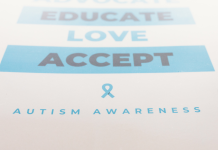 I deeply believe that the world is good. Yet, I’d be lying if I didn’t acknowledge the pain and suffering that’s seemingly ever-present in our society. As a former child welfare social worker, I had many reservations about bringing a child into this world when so many of the children I worked with daily had experienced unspeakable abuse and neglect.
I deeply believe that the world is good. Yet, I’d be lying if I didn’t acknowledge the pain and suffering that’s seemingly ever-present in our society. As a former child welfare social worker, I had many reservations about bringing a child into this world when so many of the children I worked with daily had experienced unspeakable abuse and neglect.
I found myself pulled in two opposing directions. How do I teach my children to have faith in a force bigger than us? One that always has our best interests at heart, all while preparing them for the reality that predators exist.
This dichotomy is one I’ve grappled with since becoming pregnant in 2018. How do I demonstrate to my children both faith and discretion?
The staggering truth is that “most people who sexually abuse children are our friends, partners, family members, and community members.” According to the Child Sexual Abuse Fact Sheet by The National Child Traumatic Stress Network, “About 93 percent of children who are victims of sexual abuse know their abuser. Less than 10 percent of sexually abused children are abused by a stranger.”
There are many steps we can take to protect our children from abuse. To sharpen their understanding of body safety skills, and learn the difference between “okay” and “not okay” touches. Lately, I’ve been focusing on teaching my child body boundaries as a way to be more intentional about proactive safety measures. This process involves giving her permission to feel into and express boundaries relating to her body.
It is so important to me that my daughter knows she has choices around decisions that relate to her body. I empower her every chance I can to make choices according to what is or is not comfortable for her.
Sometimes, this looks like stopping a tickle-fight right when she says “stop.” In these moments, I verbally reassure her that it’s her body. That the choice is hers and thank her for letting me know she didn’t want to continue.
This idea of choice continues into interactions with adults. Physical affection is always optional. I let her know she’s welcome to give hugs and kisses if she’d like. If she doesn’t want to she can just wave and say a welcome or a goodbye. The key is that she is tapping into what feels right for her at that moment. This builds empowerment. It avoids placing pressure on the child to override an impulse as a way of satisfying the needs or expectations of the adults around her.
Implementing boundaries is not always an easy thing to do. Some people may meet you with resistance. Those who were raised differently or have contrasting values around parenting might not agree with hugs being optional, or feel hurt by your parenting choices. And let’s not beat around the bush- that can be hard!
It might feel like a new edge or boundary for YOU as the parent, to allow your child freedom in this bodily expression. That edge can feel prickly. We don’t want to disappoint anybody or have others feeling sad or left out if our child doesn’t show them affection.
In these challenging moments, I’ve expressed to the person I love and trust that I do understand how they might be hurt if my child decides against a hug. I hold space for their feelings. I also express what’s important to me – that my children recognize their boundaries and feel empowered to assert them. At the end of the day, my role as a mother is not to please everybody, but rather, it is to keep my children safe.
The truth is, I actually want my children to experiment with their boundaries around people I trust. I want my children to understand that they can say “no” both verbally and non-verbally when it relates to certain decisions about their bodies. This repeated practice builds the confidence and neural connections in their brain necessary to stand firmly in what is right- should they ever be in a situation where their safety is potentially at risk.
We can’t remind children enough that they have agency over their bodies. Let’s be real, our littles are in the position of being told what to do quite often. Otherwise, nothing will ever get done otherwise. “Come here,” “Stay on the sidewalk,” “Pull up your pants,” “Don’t step on your brother.” When they are consistently bombarded with the necessary demands to move life along safely, it’s vital that we also remind our little ones that their body actually is theirs, and that what is or is not comfortable for them actually DOES matter.
So let children know that they have the right to make decisions about their bodies. Children should feel empowered to say no when they do not want to be touched. Even in non-sexual ways like refusing hugs, and saying no to touching others. Trust your instincts. Know that the best time to talk to your child about keeping their body safe is now.











[…] can feel like a full-time job to keep your children safe in an unpredictable world. Parenting consciously with awareness of your triggers can help you […]